Design Sprints and why they’re important
At Rokt, every employee is allotted a training allowance to spend on courses and certifications that we personally want to pursue. Aptly named “Level Up”, this program is just one of a number of benefits of working at Rokt. The Level Up program offered me the opportunity to participate in a masterclass called “Dive into Design Sprints”.
What is a Design Sprint?
A Design Sprint is a unique five-day process for validating ideas and solving big challenges through prototyping and testing ideas with customers. The book “How To Solve Big Problems and Test New Ideas in Just Five Days” by Jake Knapp refers to it as:
“The ‘greatest hits’ of business strategy, innovation, behavioural science, and more — packaged into a step-by-step process that any team can use.”
In five days, the Design Sprint will help you to:
- Understand. Map out the problem and pick an important area to focus.
- Ideate. Sketch out competing solutions on paper.
- Decide. Make decisions and turn your ideas into a testable hypothesis.
- Prototype. Hack together a realistic prototype.
- Test. Get feedback from real live users.
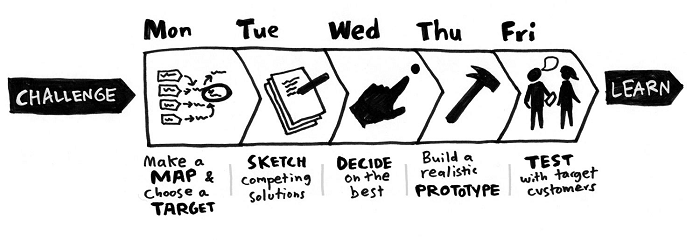
The design sprint process - from "How To Solve Big Problems and Test New Ideas in Just Five Days" by Jake Knapp
What do you need to run a Design Sprint?
- Decider. They call the shots. Whether that’s the CEO or senior executive, they should be involved in the discussions early on since their decision will influence the sprint goal and the final product.
- Facilitator. The time keeper. They keep track of the team’s progress during the Design Sprint and ensure that everyone is playing their part. They need to remain unbiased in their opinion when it comes to decision time.
- Marketing Expert. The person who is skilled at crafting your company’s messaging to your customers.
- Customer Service. They interact with your customers on a regular basis and truly understand who your users are.
- Design Expert. They design the product and help to realise the vision of the goal.
- Tech Expert. They are in the best position to understand what your company can build and deliver.
- Financial Expert. They can explain how much the project will cost and how much the company can expect to get from it in return.
Preparation:
- Block out the entire week in your team’s calendar.
- No devices are allowed in the room. This is so that the entire team is focussed 100% of the time.
- Stock up on post-it notes. You’ll need these to jot down ideas and map them on a wall.
- Whiteboards and plenty of markers.
Monday: Understand the problem
What is the long term goal?
“Why are we doing this project? Where do we want to be six months, a year or even five years from now?”
At the start of the sprint, you need to set a long term goal. This should serve as your beacon of light to keep everyone moving in the same direction. Once established, it’s important to turn the goal into actionable items by rephrasing your assumptions and obstacles into sprint questions.
For example, if your long term goal is to “build an army of loyalists through products that deliver reasons to return”; then a sprint question could be “will customers feel motivated to recommend us?”.
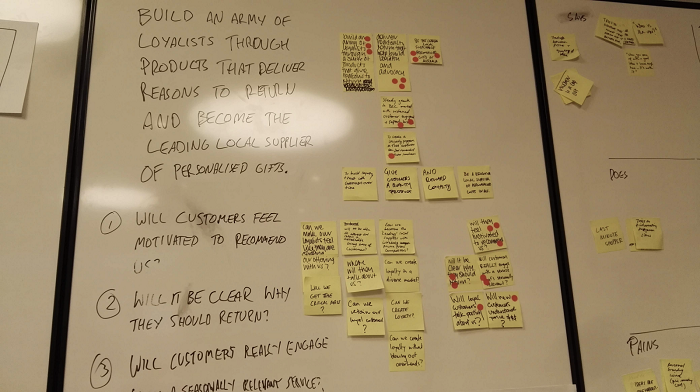
The long term goal and sprint questions that we defined.
What are your users’ pain points?
After you’ve defined your long term goal and sprint questions, start by mapping out your customer journey. It’s important to understand who your customers are, so conducting user research in advance is vital.
- Empathy mapping. The Empathy map is a visual way to better understand your users and prioritise their needs. The map helps to identify any key themes and problems affecting your users based on their quotes, actions, behaviours, pains, and feelings captured throughout the user research and expert interviews.

Our Empathy Map based on our users
- Customer Journey. The Customer Journey map helps to visualise a customer’s end-to-end experience with your product or service. This allows the team to narrow down a broad challenge to a specific target for the sprint.
- Swim lane diagram. Combining the Empathy map with the Customer Journey map will create a Swim Lane diagram. This diagram serves to create a heat map of the problems that exist within each step of the customer journey.
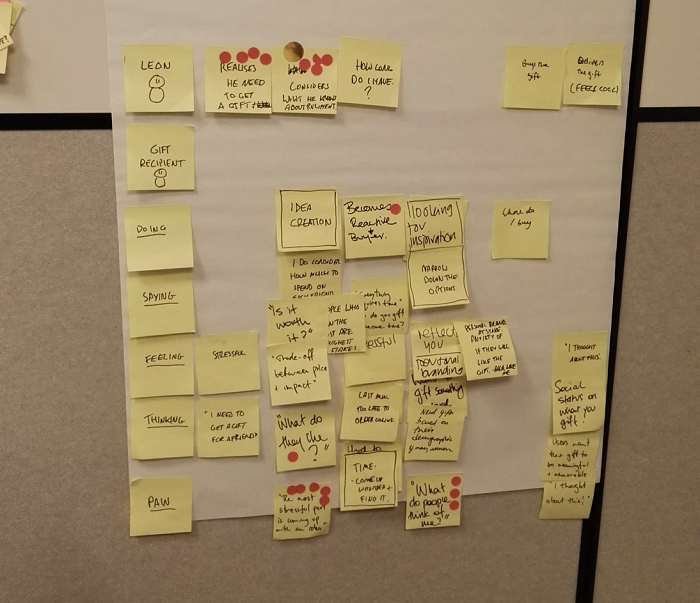
Example of a swim lane diagram
How Might We turn this problem into an opportunity?
The How Might We method is used to turn existing problems into opportunities. For example, if the problem is that “users struggle to know what to buy for their friend as a gift”, then the How Might We could be “how might we help the user better understand what they know about their friend?”.
Use the dot voting system to prioritise the How Might We notes and decide on which focus area to target for your sprint.
Which problem do we target?
“Who is the most important customer, and what’s the critical moment of that customer’s experience?”
At the end of the day, the decider needs to select one target customer and one target event on the Customer Journey map to focus on. This will become the focus problem for the rest of the sprint.
Tuesday: Ideate the solutions
Remix and improve with Lightning Demos
Lightning demos encourage your team to research competitors and find examples of existing products that could serve as inspiration for your solution. Each person should give a three-minute demo of their findings.
Sketch in four steps.
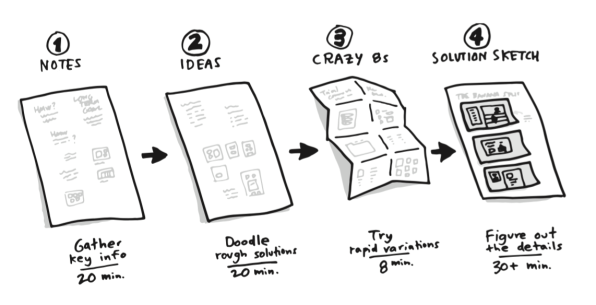
The Four-Step Sketch - from "How To Solve Big Problems and Test New Ideas in Just Five Days" by Jake Knapp
The four-step sketch method forces you to create solutions in an effective manner whilst iterating on each variation along the way.
- Notes. Start with 20 minutes to take notes of the goal, opportunities, and inspiration you’ve collected earlier on.
- Ideas. Spend another 20 minutes drawing out rough ideas to form your thoughts.
- Crazy 8s. Take your strongest solution and sketch out eight different variations of it in eight minutes, known as the ‘Crazy 8s’ exercise.
- Solution sketch. Draw a detailed end-to-end solution for the problem in the next 30 minutes or more.
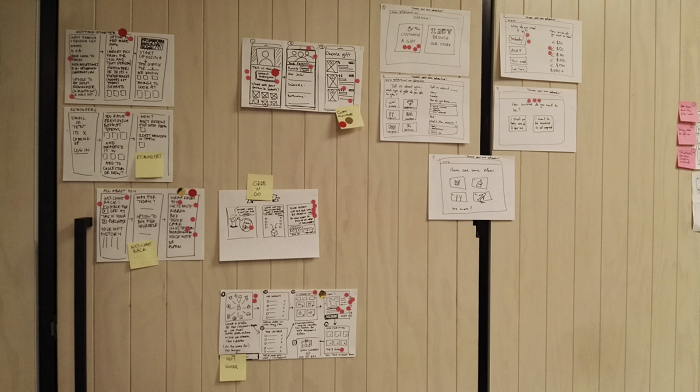
Sketches drawn by each member of the team
Wednesday: Make a decision
Decide on the best solution to prototype
The process to reaching consensus on the best solution can be carried out in five steps:
- Art museum. Put all the sketches on a wall to create an art gallery. Ideally, the sketches should be anonymous, so the facilitator should assist with hanging them up.
- Heat map. Each team member is given three dot stickers to assign to the sketches or parts of the sketches that they find interesting. This is to be done in silence.
- Speed critique. Each member selects a drawing that is not their own and quickly walks through the solution, using sticky notes to capture the big ideas.
- Dot voting. Each team member is given one vote (one dot sticker) to choose the best solution and justify their decision.
- Supervote. The decider makes the final call with three votes (three dot stickers).
Create a storyboard
On a whiteboard, draw five to seven frames (and up to no more than 15) to start the storyboard. The first frame should contain the opening scene to provide context and familiarity to your users just before they interact with your product. For example, it could be a simple web search, a store shelf, app store or social media site.
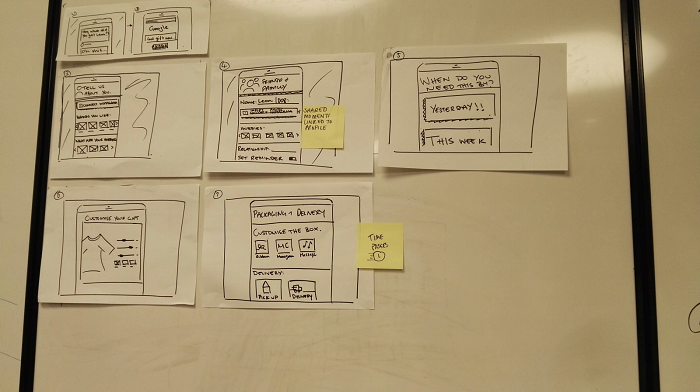
Our story board captured in 6 frames
Thursday: Create a prototype
Once you’ve drawn out the storyboard, devote the entire day to building the prototype. The secret to building a prototype is to fake it.
Aim to create a prototype of “Goldilocks quality”. Ideally the quality should be good enough so that it appears real to users but not too much that you spend forever perfecting it. For example, creating mockups using Sketch or Keynote and importing that into a prototyping tool like Invision is an easy way to get software prototypes out quickly.
To tackle the task, the sprint team should be split up into the following:
- Makers. Usually at least two designers or engineers responsible for creating the individual components of the prototype.
- Stitcher. Either a designer or engineer should be collecting the components from the Makers and combining them into a seamless fashion.
- Writer. Usually the product manager should be writing realistic text to ensure that the language makes sense to the user.
- Asset Collector. They are responsible for scouring the web and image libraries to provide photos, icons or relevant content to assist the Makers.
- Interviewer. They should write the interview script for Friday’s customer interviews .
Friday: Test your prototype with users
Test it with users
When it comes to user testing, the Nielsen model suggests that you only need to interview five users who fit in with your target customer profile. The rationale behind this is that testing more than five users diminishes the value of return since you will already have identified 85% of the problems after listening to five people.
The questions and tasks that you ask the user to perform during the interview should simulate a real world environment whilst the sprint team watches the recording in a separate room.
Learning from feedback
Ideally, you should watch the recordings together as a group. Draw a table on a whiteboard divided up into five columns for the five customers and rows for each area or task of the prototype they addressed.

Design sprint interviews grid - from "How To Solve Big Problems and Test New Ideas in Just Five Days" by Jake Knapp
Look for patterns and themes in the feedback and work towards prioritising these into your backlog as items or features to address in the next iteration of your product.
Key takeaways
- The user is king. The entire design sprint process is user-centred. It builds products and services based on a solid understanding of the user’s wants and needs and asks for feedback and validation directly from them towards the end of the sprint.
- Considers all perspectives. Design Sprints gather all important people in one place. This means that there’s less bureaucracy and siloed structure in the organisation because the process facilitates cross-team collaboration.
- It’s efficient and effective. A sprint cuts out all inefficiencies and ineffective discussions. No more dreadful back-to-back meetings that take up your entire day leaving you with little time to get anything done. A five-day sprint forces you and your team to focus and work towards something realistic by the end of the week.
- Manages your stakeholder expectations. There is clear visibility and alignment from everyone on Day 1. Getting your stakeholders’ buy-in early on and throughout the sprint discussions builds trust and respect between all parties.
- Learn fast, fail fast. The sprint helps to obtain a clear vision of the goals upfront. It forces you to make critical decisions and solve complex problems fast. This means that you and your team can save months of design, engineering and, development costs. The bonus? You’ll be able to get your product to market faster because you focussed on the right thing.
Final words
I found the Design Sprint masterclass to be a great introduction to the concept and methodology. In comparison to the book (which I would also recommend reading), it was a fun and interactive way to get practical experience in a classroom environment. I plan to use this process in my work going forward and hope to influence how other people in my organisation view and approach complex problems.

